Experimental Investigation of a Pilot Solar-Assisted Permeate Gap Membrane Distillation
Abstract
:1. Introduction
2. Solar-Assisted Membrane Distillation Systems—State of the Art
3. Material and Methods
3.1. Experimental Setup
3.2. Instrumentation
4. Experimental Results and Discussion
4.1. The Effect of Global Radiation on the Production Unit
4.2. Impact of the Feed Stream Rate on Fresh Water Production
5. Execution Pointers
5.1. Explicit Thermal Power Utilization or STEC
5.2. Gained Output Ratio or GOR
6. Distillate Quality
7. Economic Study
8. Conclusions
Author Contributions
Funding
Institutional Review Board Statement
Informed Consent Statement
Data Availability Statement
Acknowledgments
Conflicts of Interest
Nomenclature
| I | sunlight based radiation (W/m2) |
| Tamb | surrounding temperature (°C) |
| Tscin | channel water temperature of the water sunlight based authority (°C) |
| Tsco | outlet water temperature of the water sunlight based gatherer (°C) |
| Tein | entrance water temperature of the channel of the evaporator (°C) |
| Teout | outlet water temperature of the channel of the evaporator (°C) |
| Tcin | entrance water temperature of the condenser channel (°C) |
| Tcout | outlet water temperature of the condenser channel (°C) |
| Tdist | water temperature of the distillate (°C) |
| QHX | complete energy input needed for the refining cycle [kWh] |
| mP | mass stream pace of pervade creation [kg/h] |
| mF | mass stream pace of the feed water [kg/h] |
| ΔHv | water idle warmth of vaporization in [kj/kg] |
| Asolar | absolute opening zone of the sun based authority field [m2] |
| msolar | mass stream rate in the sunlight based gatherer field [kg/s] |
| CPF | isobaric explicit warmth limit of the feed water [kJ/ (kg °C)] |
References
- International Renewable Energy Agency. Renewable Energy in the Water, Energy & Food Nexus; IRENA: Abu Dhabi, United Arab Emirates, 2015. [Google Scholar]
- Hameeteman, E. Future Water. In Security: Facts, Figures, and Predictions; Global Water Institute: Brussels, Belgium, 2013. [Google Scholar]
- Winter, D. Membrane Distillation: A Thermodynamic, Technological and Economic Analysis; Deutsche Natioanlbibliothek: Aachen, Germany, 2015. [Google Scholar]
- Global Water Intelligence. Desalination Industry Enjoys Growth Spurt as Scarcity Starts to Bite. Available online: https://www.globalwaterintel.com/desalination-industry-joys-growthspurt-scarcity-starts-bite.Html (accessed on 13 May 2018).
- Koschikowski, J.; Wieghaus, M.; Rommel, M.; Ortin, V.S.; Suarez, B.P.; Betancort Rodríguez, J.R. Experimental investigations on solar driven stand-alone membrane distillation systems for remote areas. Desalination 2009, 248, 125–131. [Google Scholar] [CrossRef]
- Koschikowski, J.; Wieghaus, M.; Rommel, M. Solar thermal driven desalination plants based on membrane distillation. Water Sci. Technol. Water Supply 2003, 3, 49–55. [Google Scholar] [CrossRef]
- Burhan, M.; Shahzad, M.W.; Ybyraiymkul, D.; Oh, S.J.; Ghaffour, N.; Ng, K.C. Performance investigation of MEMSYS vacuum membrane distillation system in single effect and multi-effect mode. Sustain. Energy Technol. Assess. 2019, 34, 9–15. [Google Scholar] [CrossRef]
- Mahmoudi, F.; Siddiqui, H.; Pishbin, M.; Goodarzi, G.; Dehghani, S.; Date, A.; Akbarzadeh, A. Sustainable Seawater Desalination by Permeate Gap Membrane Distillation Technology. Energy Procedia 2017, 110, 346–351. [Google Scholar] [CrossRef]
- Suwaileh, W.; Johnson, D.; Jones, D.; Hilal, N. An integrated fertilizer driven forward osmosis- renewables powered membrane distillation system for brackish water desalination: A combined experimental and theoretical approach. Desalination 2019, 471, 114126. [Google Scholar] [CrossRef]
- Khalifa, A.E.; Alawad, S.M. Air gap and water gap multistage membrane distillation for water desalination. Desalination 2018, 437, 175–183. [Google Scholar] [CrossRef]
- Cheng, L.; Zhao, Y.; Li, P.; Li, W.; Wang, F. Comparative study of air gap and permeate gap membrane distillation using internal heat recovery hollow fiber membrane module. Desalination 2018, 426, 42–49. [Google Scholar] [CrossRef]
- Asim, M.; Uday Kumar, N.T.; Martin, A.R. Feasibility analysis of solar combi-system for simultaneous production of pure drinking water via membrane distillation and domestic hot water for single-family villa: Pilot plant setup in Dubai. Desalination Water Treat. 2015, 57, 21674–21684. [Google Scholar] [CrossRef]
- Guillén-Burrieza, E.; Blanco, J.; Zaragoza, G.; Alarcón, D.-C.; Palenzuela, P.; Ibarra, M.; Gernjak, W. Experimental analysis of an air gap membrane distillation solar desalination pilot system. J. Membr. Sci. 2011, 379, 386–396. [Google Scholar] [CrossRef]
- Winter, D.; Koschikowski, J.; Wieghaus, M. Desalination using membrane distillation: Experimental studies on full scale spiral wound modules. J. Membr. Sci. 2011, 375, 104–112. [Google Scholar] [CrossRef]
- Manna, A.K.; Sen, M.; Martin, A.R.; Pal, P. Removal of arsenic from contaminated groundwater by solar-driven membrane distillation. Environ. Pollut. 2010, 158, 805–811. [Google Scholar] [CrossRef]
- Raluy, R.G.; Schwantes, R.; Subiela, V.J.; Peñate, B.; Melián, G.; Betancort, J.R. Operational experience of a solar membrane distillation demonstration plant in Pozo Izquierdo-Gran Canaria Island (Spain). Desalination 2012, 290, 1–13. [Google Scholar] [CrossRef]
- Chang, H.; Lyu, S.-G.; Tsai, C.-M.; Chen, Y.-H.; Cheng, T.-W.; Chou, Y.-H. Experimental and simulation study of a solar thermal driven membrane distillation desalination process. Desalination 2012, 286, 400–411. [Google Scholar] [CrossRef]
- Zaragoza, G.; Ruiz-Aguirre, A.; Guillén-Burrieza, E. Efficiency in the use of solar thermal energy of small membrane desalination systems for decentralized water production. Appl. Energy 2014, 130, 491–499. [Google Scholar] [CrossRef]
- Banat, F.; Jwaied, N.; Rommel, M.; Koschikowski, J.; Wieghaus, M. Desalination by a compact SMADES autonomous solar-powered membrane distillation unit. Desalination 2007, 217, 29–37. [Google Scholar] [CrossRef]
- Thomas, K. Overview of Village Scale. Renewable Energy Powered Desalination 1997, NREL/TP-440 22083, UC Category: 1210 DE 97000240; National Renewable Energy Laboratory: Golden, CO, USA, 1997.
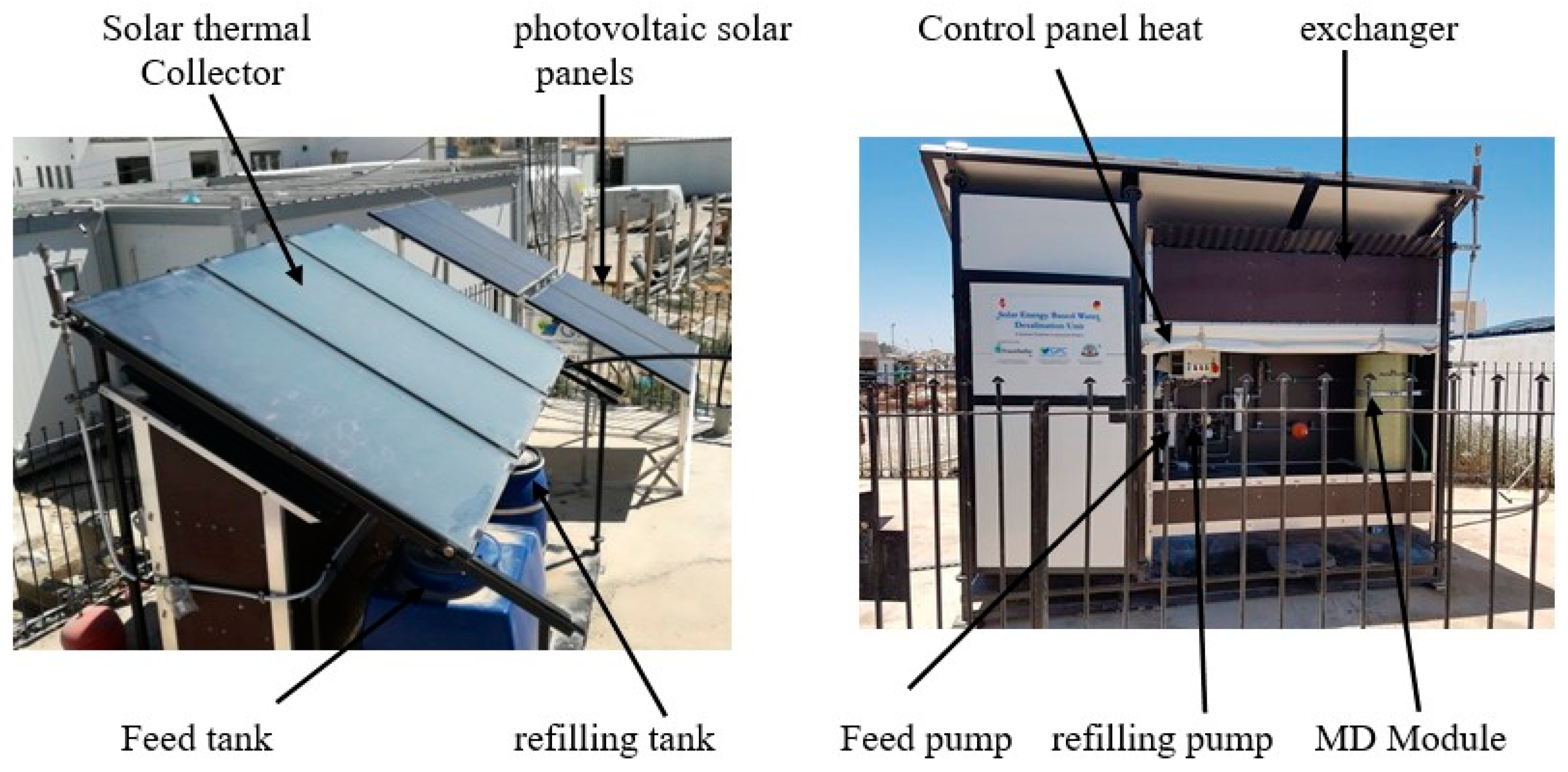
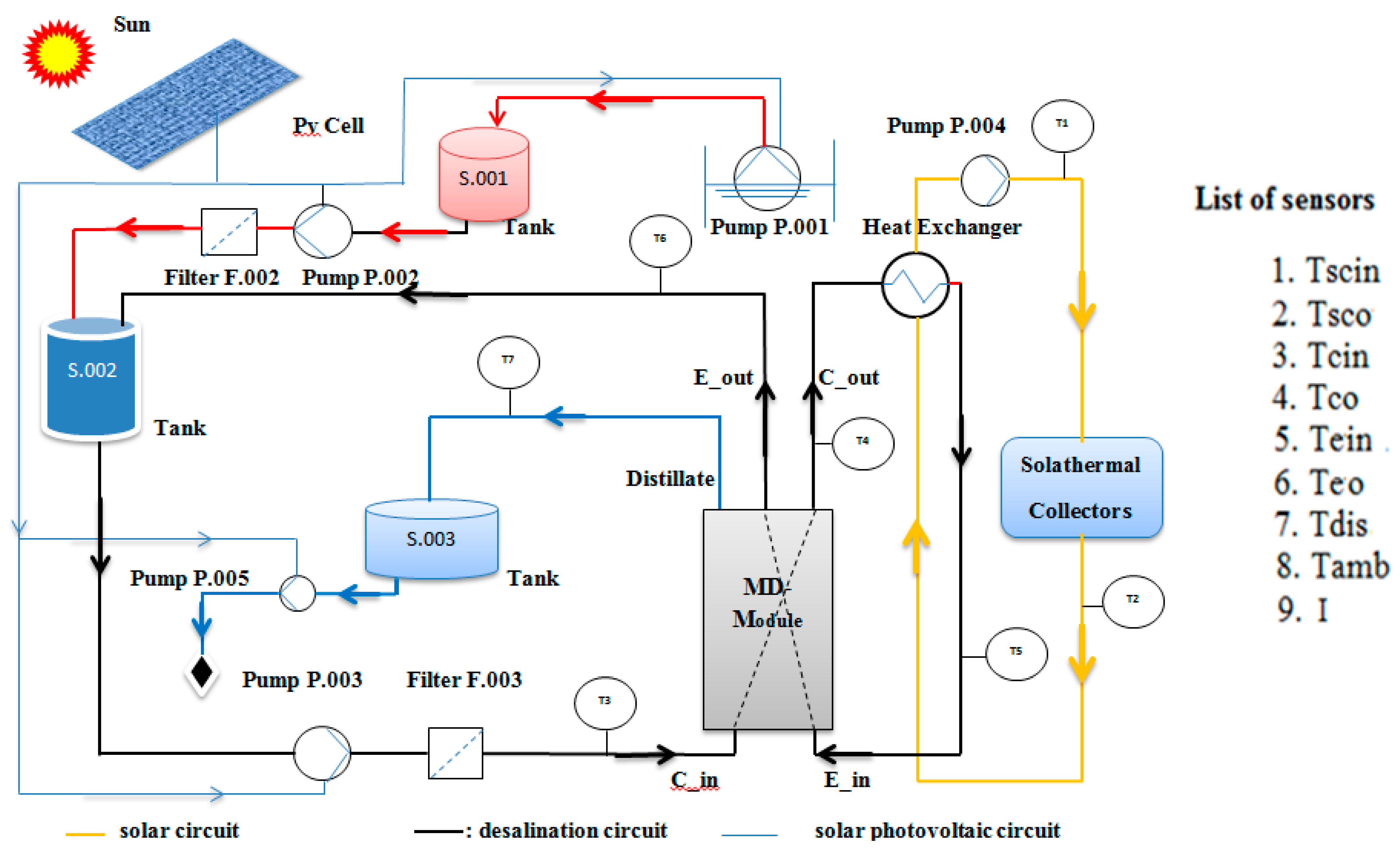
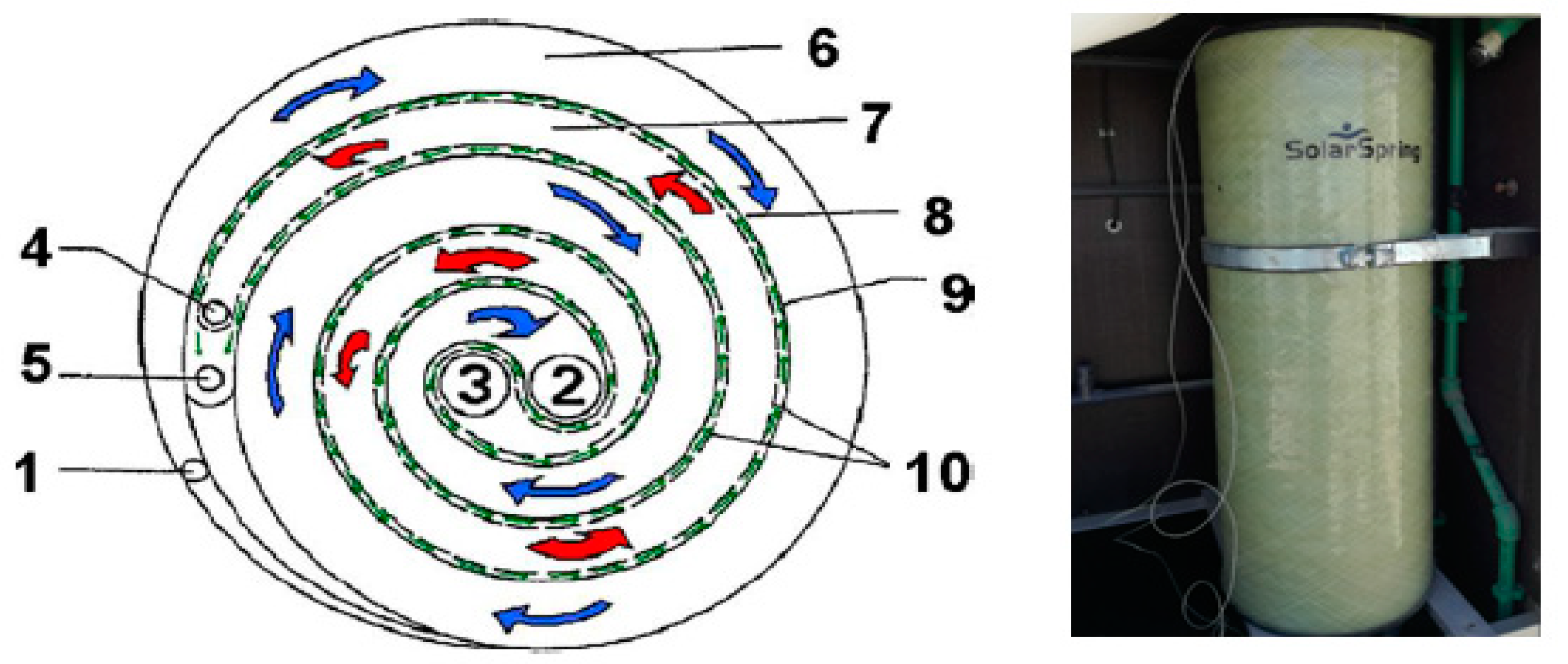
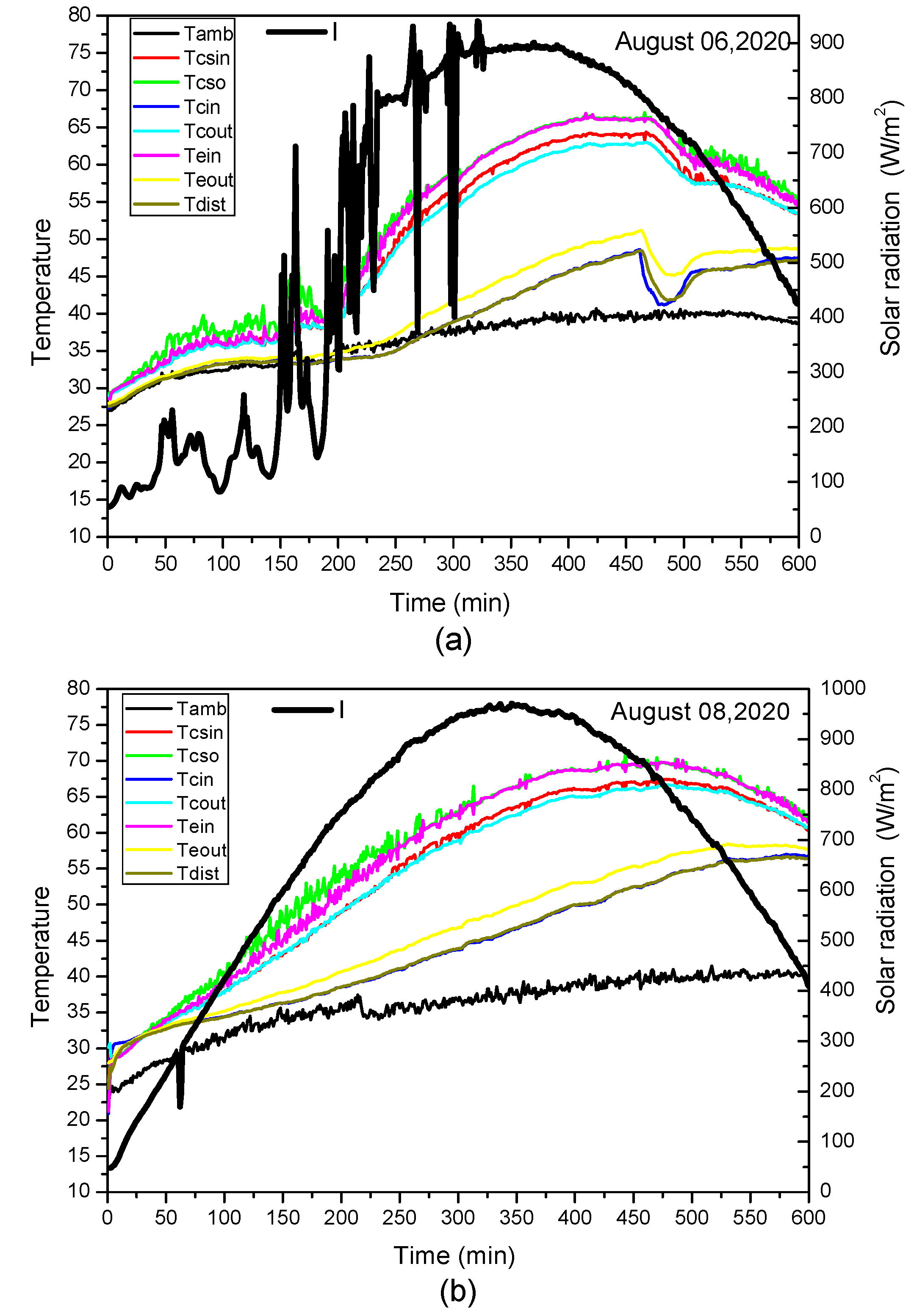
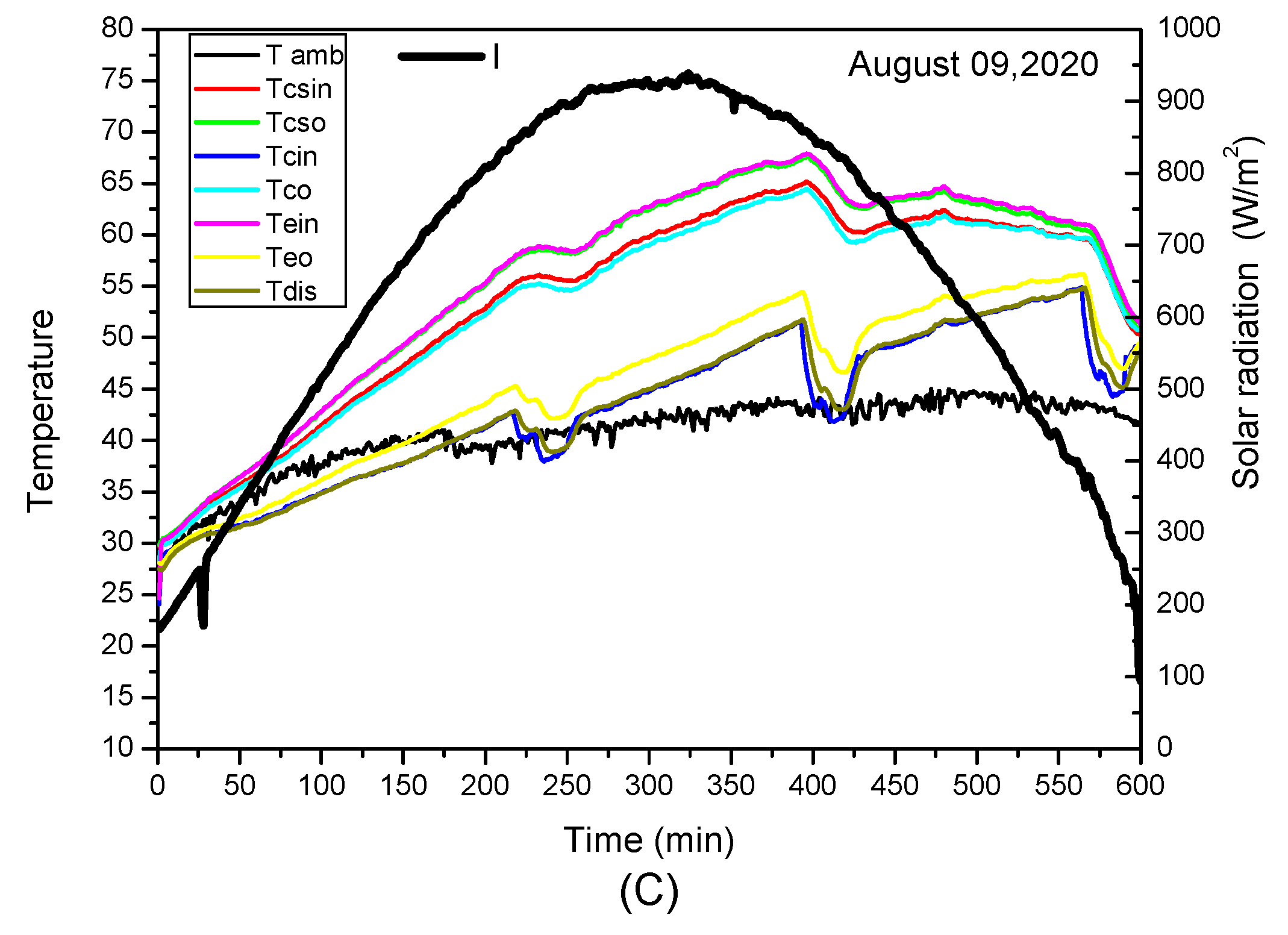
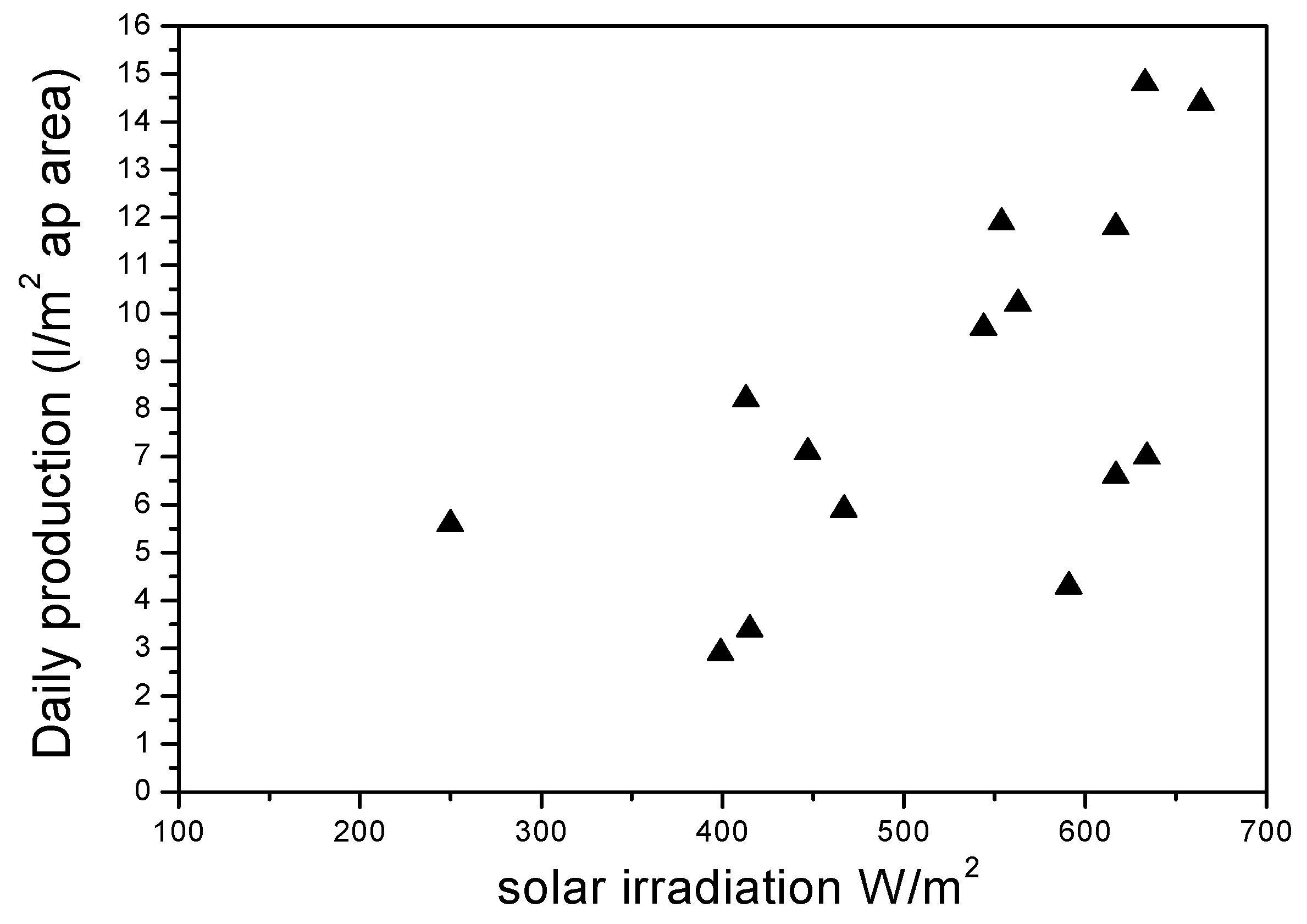
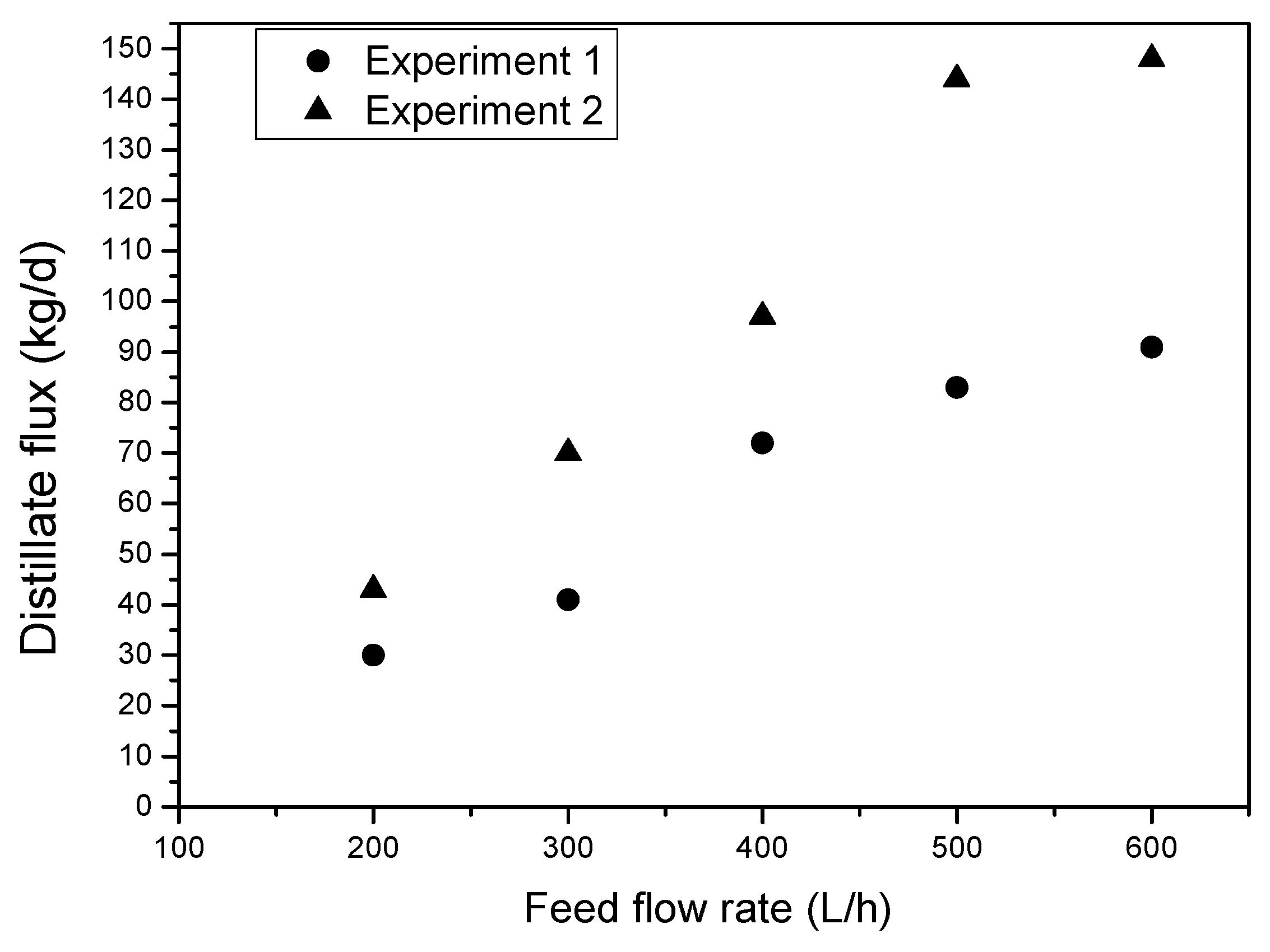
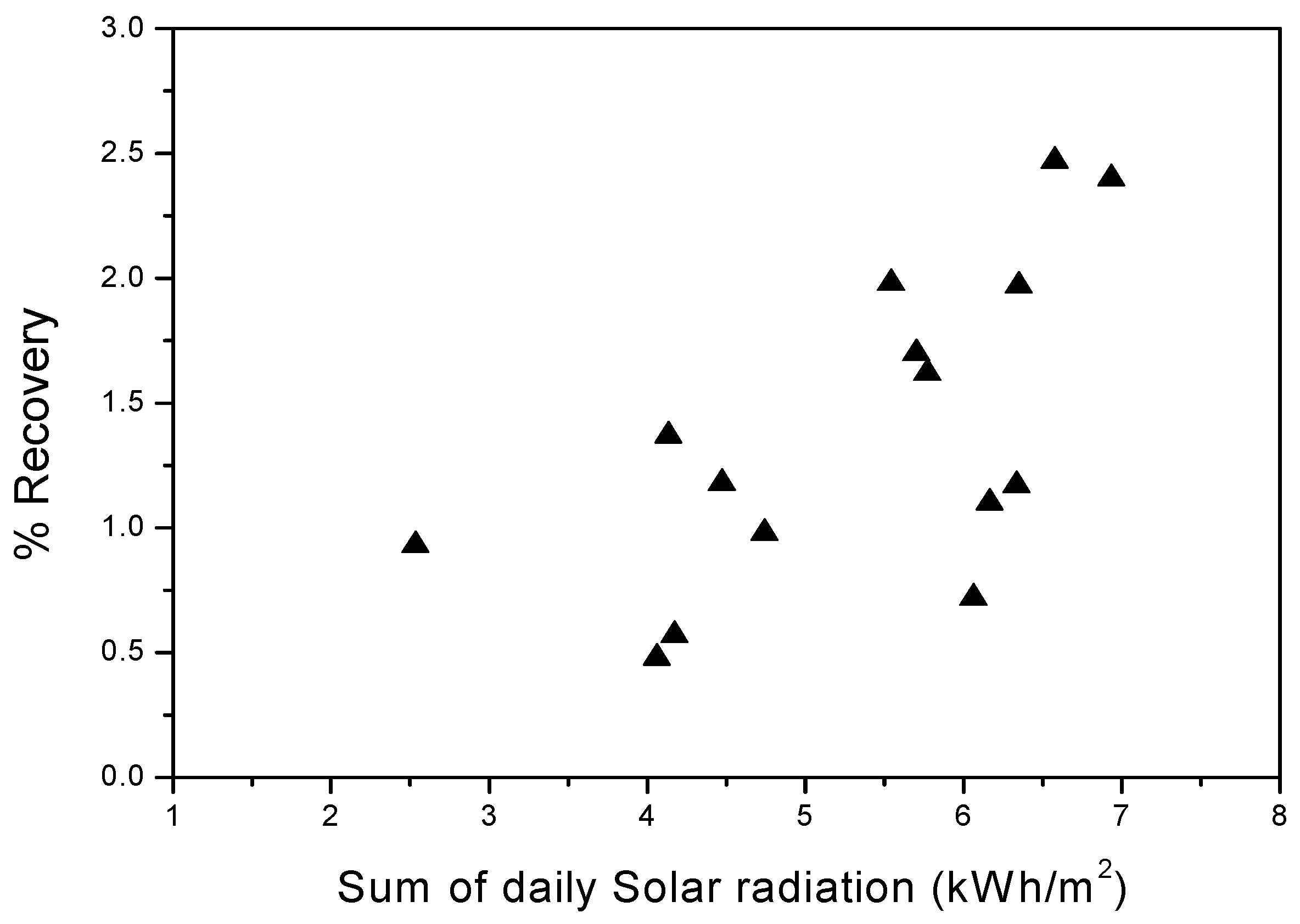

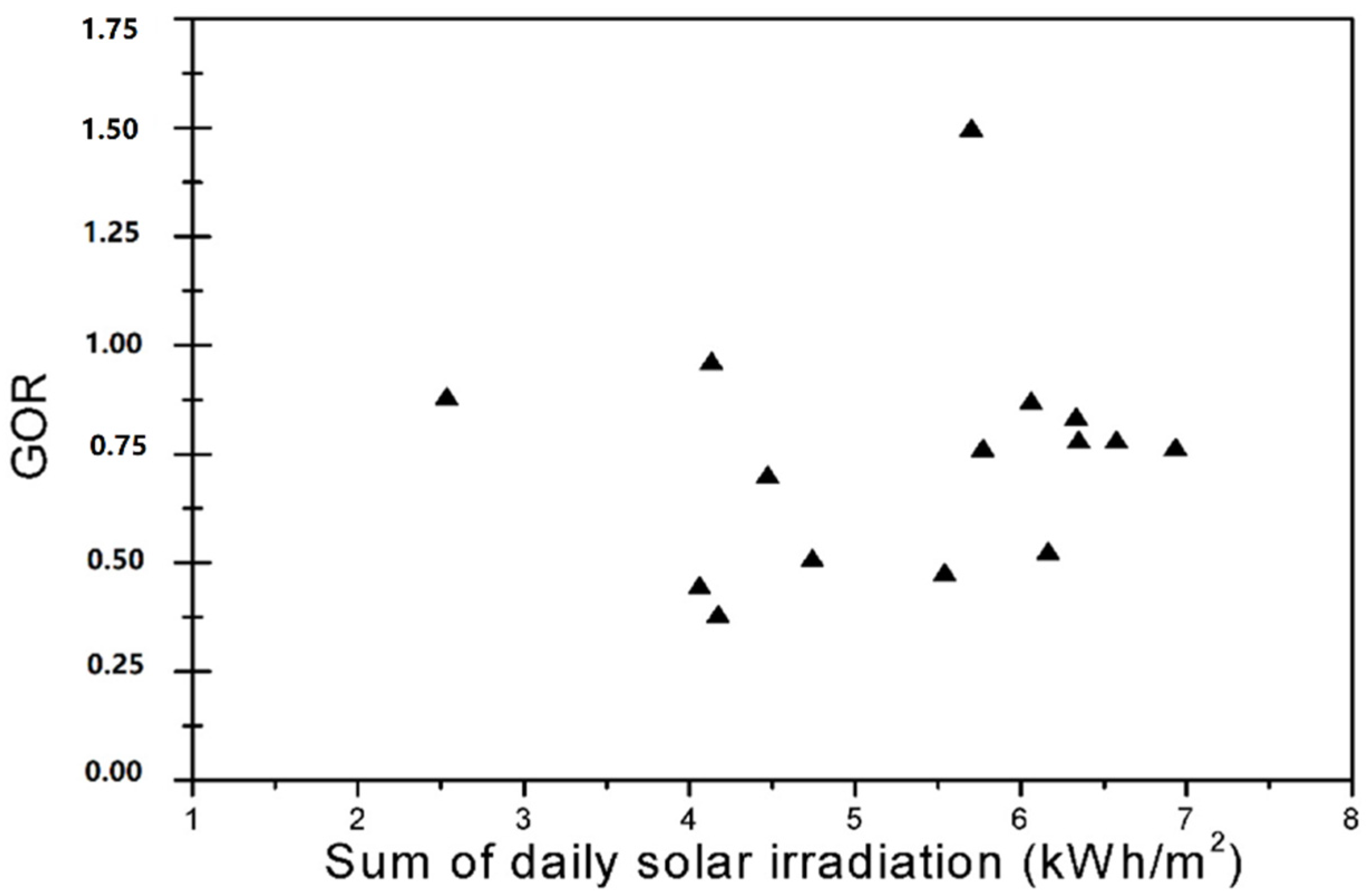
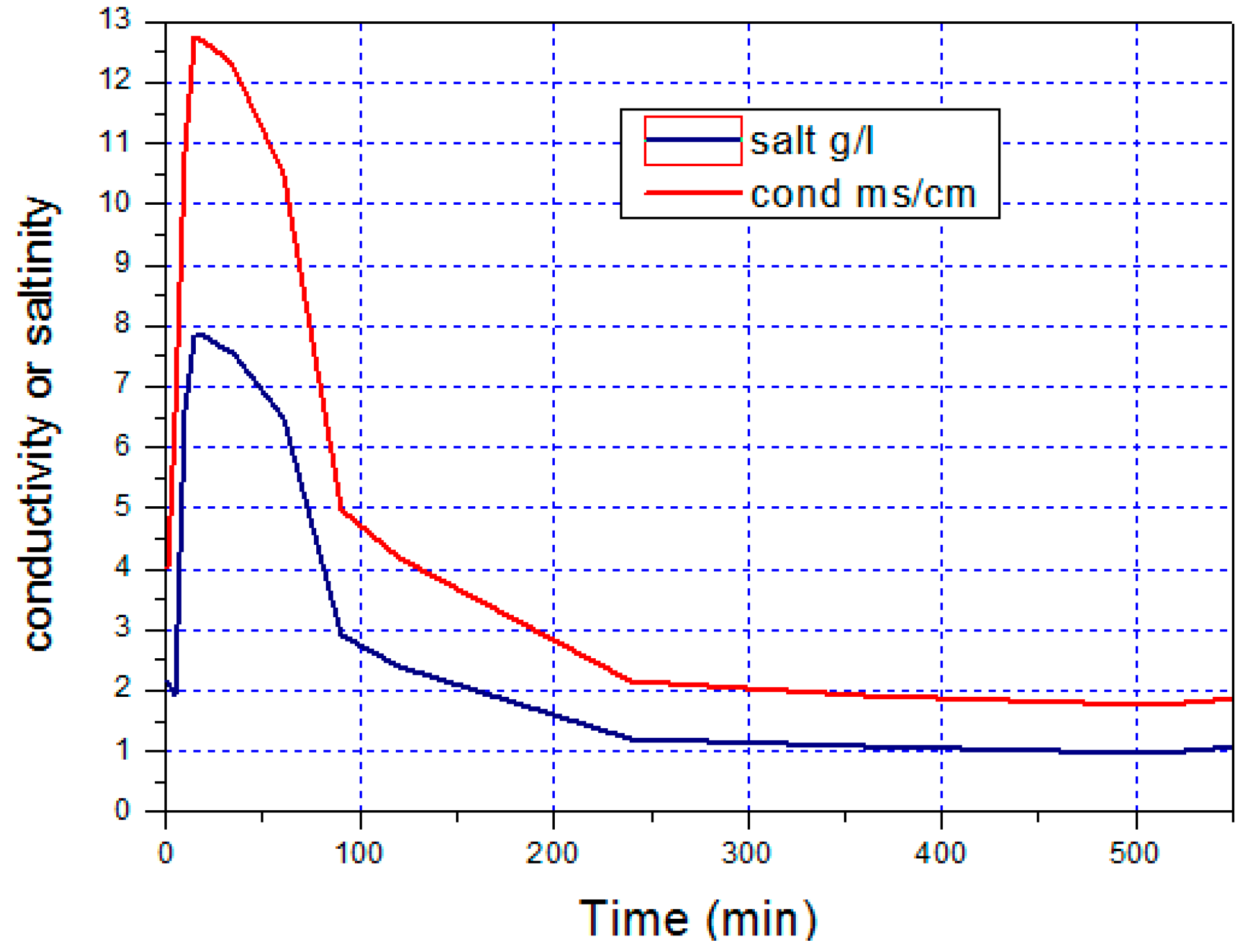
| Water Solar Collector | Membrane Distillation | Pv Monocrystalline Module | |||
|---|---|---|---|---|---|
| Area | 2 m2 | Area | 10 m2 | Temperature range | −40 to 85 °C |
| Tube material | copper | Module-height | gross = 900 mm net = 725 mm | Module dimension | 1.640 × 992 mm |
| Tube thickness | 0.002 m | Material | Polytetrafluoroethylene (PTFE) | weight | 21 Kg |
| Rise-outer diameter | 0.0127 m | Length | 73 mm | Impp | 8.07 A |
| Rise thickness | 0.56 × 10 | Pore diameter | 0.1–0.4 μm | Vmpp | 30.55 V |
| Thickness of insulation | 0.1 m | nature separation | hydrophobic | Wp | 245 W |
| Weight | 48 kg | condenser diameter | 20 mm | ||
| Angle | 45° | Evaporator diameter | 20 mm | ||
| Loss coefficient | 4.8 W/m2 k | distillate diameter | 20 mm | ||
| Component | Type | Description | Value |
|---|---|---|---|
| Thermocouple | Type J | Temperature sensors | −50 °C–400 °C |
| Pyranometer | LP LYPRA 03AC | Measuring Range | 0–2000 W/m2 |
| Pump | Shurflo LS2255 | Refilling | Open flow 13.6 L/mn |
| Pump | Shurflo LS2255 | Feed | Open flow 13.6 L/mn |
| Feed volume flow | 60/185(2/96) | H2O with 20 °C | -- |
| iden Nr: 15002 | |||
| PLC | Agilent BenchLink | Data Logger 3 Agilent 34970a | -- |
| Conductivity Meter | CD-4307SD | Measuring cd, salt | 0 to 200 ms, 0 to 12% salt (% weight) |
| Parameter | Unit | 2 August 2020 | 3 August 2020 | 6 August 2020 | 8 August 2020 | 9 August 2020 |
|---|---|---|---|---|---|---|
| Avg. Solar Radiation | W/m2 | 601.3 | 637.62 | 584.61 | 682.22 | 677.56 |
| Max. solar radiation | W/m2 | 859.6 | 896.7235 | 939.98 | 951.37 | 978.27 |
| mfeed | kg/h | 200 | 300 | 400 | 500 | 600 |
| distillat | kg/d | 46.60 | 73.40 | 101.80 | 142.60 | 159.20 |
| Avg. Tamb | °C | 40.908 | 42.23 | 38.39 | 39.87 | 42.61 |
| Max. Tamb | °C | 44.773 | 47.99 | 40.64 | 41.47 | 46.13 |
| Avg. Tsco | °C | 59.53 | 65.44 | 54.41 | 58.13 | 57.37 |
| Max. Tsco | °C | 88.21 | 89.86 | 66.99 | 69.79 | 71.58 |
| Avg. Tein | °C | 52.73 | 57.25 | 53.51 | 57.39 | 59.71 |
| Max. Tein | °C | 76.08 | 71.884 | 66.88 | 70.211 | 71.91 |
| Prototype Components | Quantity | Cost (€) | Total Cost (€) |
|---|---|---|---|
| Photovoltaic module 245 W | 4 | 188.5 | 754 |
| Thermal solar collector 2 m2 | 3 | 214.6 | 643.8 |
| Compact distillation module (PGMD, Pumps, filters, feed tank, and heat exchanger) | 1 | 11,000 | 11,000 |
| Piping/Connection accessory | 1 | 681.5 | 681.5 |
| Circulation pump | 1 | 101.5 | 101.5 |
| DC pumping system | 1 | 1044 | 1044 |
| DC/AC protection box | 1 | 275.5 | 275.5 |
| Wiring and cable routing | 1 | 217.5 | 217.5 |
| Battery/charge regulator/Inverter | 1 | 788.8 | 788.8 |
| Structure | 1 | 174 | 174 |
| Capital cost | 15,680.6 € |
| Operating and maintenance costs (Co&m) | 250,886 € year−1 |
| Lifetime (n) | 20 year |
| Interest rate (i) | 5% |
| Amortization factor (a) | 0.080 year−1 |
| Fixed charges (Cfixed) | 125,444 € year−1 |
| Total unit cost | 150,533 € year−1 |
| Unit availability (f) | 90% |
| Unit capacity | 0.148 m3 d−1 |
| Water production cost (WPC) | 30.96 € m−3 |
| Net earning | 30.95 |
| Payback period (Pb) | 506.60 d |
Publisher’s Note: MDPI stays neutral with regard to jurisdictional claims in published maps and institutional affiliations. |
© 2021 by the authors. Licensee MDPI, Basel, Switzerland. This article is an open access article distributed under the terms and conditions of the Creative Commons Attribution (CC BY) license (https://creativecommons.org/licenses/by/4.0/).
Share and Cite
Alquraish, M.M.; Mejbri, S.; Abuhasel, K.A.; Zhani, K. Experimental Investigation of a Pilot Solar-Assisted Permeate Gap Membrane Distillation. Membranes 2021, 11, 336. https://doi.org/10.3390/membranes11050336
Alquraish MM, Mejbri S, Abuhasel KA, Zhani K. Experimental Investigation of a Pilot Solar-Assisted Permeate Gap Membrane Distillation. Membranes. 2021; 11(5):336. https://doi.org/10.3390/membranes11050336
Chicago/Turabian StyleAlquraish, Mohammed M., Sami Mejbri, Khaled A. Abuhasel, and Khalifa Zhani. 2021. "Experimental Investigation of a Pilot Solar-Assisted Permeate Gap Membrane Distillation" Membranes 11, no. 5: 336. https://doi.org/10.3390/membranes11050336
APA StyleAlquraish, M. M., Mejbri, S., Abuhasel, K. A., & Zhani, K. (2021). Experimental Investigation of a Pilot Solar-Assisted Permeate Gap Membrane Distillation. Membranes, 11(5), 336. https://doi.org/10.3390/membranes11050336






